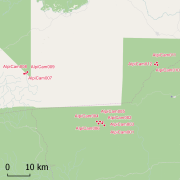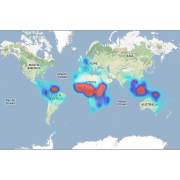species distribution
Type of resources
Topics
Keywords
Contact for the resource
Provided by
Years
Formats
Representation types
Update frequencies
status
Scale
-

This dataset is contains herbarium specimens collected in the Dzanga-Sangha Reserve in the Central African Republic. These data are collected and used by David Harris at the Royal Botanic Garden Edinburgh, scientific collaboration are welcomed, please get in touch with a point of contact.
-

This database records the collection of leaf or cambium samples of African plants (mostly Guineo-Congolian forest trees) conserved at the Evolutionary Biology and Ecology Unit of the Université Libre de Bruxelles (team lead by Olivier Hardy) for DNA analyses. The material is used for genetic analyses in the fields of phylogenetics, population genetics and phylogeography. Each sample has a unique identifier in the form of 2-3 letters (most often the initials of a collector) followed by a 4 digit number. A sampe corresponds to one individual plant collected in the field, or sometimes taken from an herbarium voucher conserved in a herbarium collection, which has been identified to species or genus level and geolocated.
-

Africadiv is a network of 1-ha forest monitoring plots spread across the moist forests in central Africa. This dataset holds the inventory of tree species in the Cameroonian site of Mindourou II. In each plot, the diameter at breast height (DBH) of all trees with DBH ≥ 10 cm have been measured (n=5598). All trees were identified in the field by expert botanists. Leaves samples were frequently collected for genetic analyses along with herbarium samples. The herbarium and leave samples are conserved at the Herbarium of the Université Libre de Bruxelles (BRLU, Belgium) and the determination of the samples is frequently updated by ULB's botanists. End of 2016, the identification rate was: 56.4% on species-level, 26.2% on genus-level, 11.7% on family-level. 5.7% remained unidentified.
-

This database contains botanical records either relating to material present in one of the Naturalis collections, or to material that has been or is being used in research projects. The records usually relate to herbarium specimens, but it also contains data on silica-gel samples, wood samples, spirit collections, carpological collections, etc. rarely to observations only.
-

This dataset gathers the floristic composition in a network of about 100 transects across terra firme forests in Gabon, considering stems above or equal to 5 cm diameter at breast height. In each transect, the following data are collected : 1. Diameter at breast height (dbh), 2. Species identification. Herbarium samples are conserved at the Herbarium of the Université Libre de Bruxelles (BRLU, Belgium) and the database is frequently updated by ULB's botanists. 3. GPS geolocation. These data are collected and used by Evolutionnary Biology and Ecology unit from the Université Libre de Bruxelles (ULB) and Missouri Botanical Garden (MBG), Central Africa Program.
-

This dataset gathers the digitized data of herbarium collections present in the Herbarium of the Université Libre de Bruxelles, Belgium. The majority of the samples originates from Africa. Most of the collection consists of dried plants mounted on herbarium sheets, but it also comprises special collections preserved in alcohol and a collection of dried samples in silica-gel. The best represented countries in the collection are Congo (RDC), Equatorial Guinea, Central African Republic, Congo Brazzaville, São Tomé and Príncipe, Cameroon and Gabon. Each entry has data on: 1. Taxonomic identity 2. Geographic location 3. Collector and collecting information
-

This dataset gathers description for available herbarium specimens on Orchidaceae endemic to Atlantic Central Africa. It contains about 2054 georeferenced records. These data are collected/compiled by V. Droissart, B. Sonké, and T. Stévart, and used by the RAINBIO project.
-

The dataset holds georeferenced records in african countries from the Royal Botanic Gardens herbarium database in Kew (K). We downloaded the dataset on 9 December 2014 from the Global Biodiversity Information Facility (GBIF). Each entry has data on: 1. Taxonomic identity 2. Geographic location 3. Collector and collecting information
-

This database contains botanical records either relating to material present in one of the Naturalis collections, or to material that has been or is being used in research projects. The records usually relate to herbarium specimens, but it also contains data on silica-gel samples, wood samples, spirit collections, carpological collections, etc.; rarely to observations only. The Naturalis collections have their strong points in The Netherlands and surrounding countries, Southeast Asia and New Guinea, West- and Central-Africa, Ethiopia and the Guyanas.
-

Habitats inventories have been installed over the years in French Guiana using a standardized multi-scale protocol. In each site, we established two to four transects, about 2.5 to 3-km long in different directions to optimally sample the local environmental variability. Each 20-m width transect was divided into 100 m segments so that the basic sampling units are 0.2-ha plots. All the plots were geo-referenced using a Garmin 76CSx GPS receiver and delineated in the field using a Vertex laser clinometer. In each plot, all trees (including palm-trees) greater than 20 cm diameter at breast height (DBH) or above the buttresses were identified by local forest-plotters from ONF. They referred to a vernacular nomenclature whose names correspond either to a botanical species, genus or family. Tested against true botanical data on 4279 trees (Guitet et al., 2014), this nomenclature proved 83% effective accuracy at the family level and 74% at the level of the most precise botanical equivalent of our vernacular names (i.e. the species, genus or family level depending on the precision reached by forest-plotters). Soil samples were also collected in 490 selected plots representative of the different topographical positions along each transect. Chemical and textural analyses are available. Plants of the under-storey have been collected by IRD in several 5m x 5m sub-plots on different sites : Kourouaï, Piton Baron, Aïmara, Saut Parasol, Mont Itoupé, Waki, Toponowini, Bagote, Haute Beiman, Roche Koutou, Regina. Standardized line transects surveys were conducted by ONCFS in 25 sites on the same transects in order to record large mammals and terrestrial birds. Transects were walked at less than 1 kmh-1 speed every morning (7:00-11:00) and afternoon (14:30-18:00) by only one observer by trail, systematically alternating transects on consecutive days to avoid observer bias. All encounters of focus species and their localization on the trail were systematically recorded and the perpendicular distance between animal and transect was measured with a laser ranger finder to the nearest meter.
 Metadata catalogue
Metadata catalogue